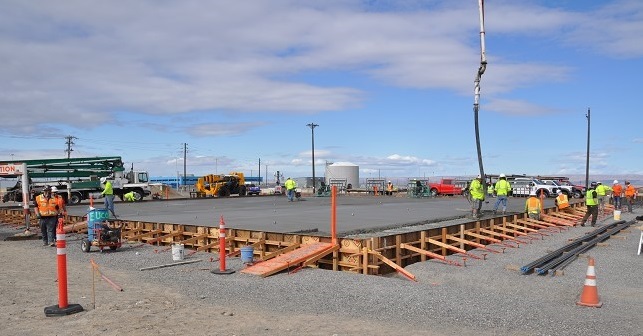 A concrete pad that will be the future interim storage area for 1,936 highly radioactive capsules of cesium and strontium is now in place at the Hanford Site. Moving the capsules from underwater pools to safer dry storage will save more than $6 million in annual operating costs.
RICHLAND, Wash. – After years of planning, the future interim storage area for nearly 2,000 highly radioactive capsules is taking shape at the Hanford Site.
EM Richland Operations Office (RL) and contractor CH2M HILL Plateau Remediation Company (CHPRC) recently finished pouring two large concrete pads for a dry cask storage area where 1,936 capsules of radioactive cesium and strontium will be moved from an underwater basin at the nearby Waste Encapsulation and Storage Facility (WESF).
Check out this video, including a time-lapse of the concrete pour, to learn more about the capsule transfer project.
The capsules have been stored at WESF since the mid-1970s. Cesium and strontium were removed from waste tanks at Hanford to reduce the temperature of the waste inside the tanks.
“While the capsules are currently in a safe and compliant configuration in underwater pool cells, WESF is an aging facility,” said Gary Pyles, RL project director for the WESF project. “Transferring the capsules to dry storage in stainless steel and concrete casks reduces the risk of a radioactive release in the unlikely loss of water from the basin.”
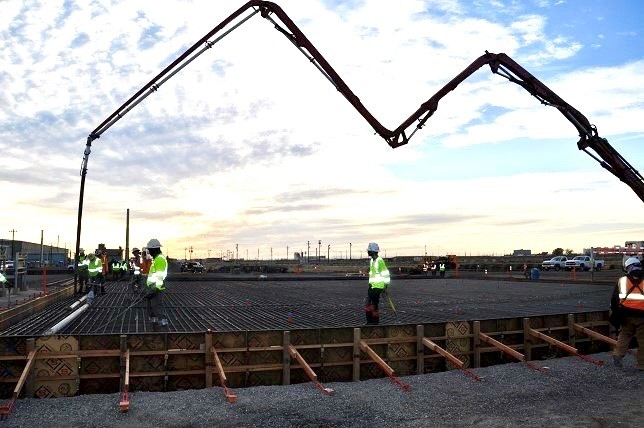 Workers with contractor CH2M HILL Plateau Remediation Company got an early morning start pouring concrete for the pads that will be used to safely store large, dry casks containing radioactive cesium and strontium capsules.
One 90-square-foot, 18-inch-thick concrete slab will hold the dry casks. A second, even larger slab provides space for workers to safely maneuver the casks onto the storage pad, as well as provide additional storage and a testing area.
The dry cask storage system is designed for passive cooling by the airflow within the cask. This same passive cooling approach is used for dry storage of used nuclear fuel at other locations. The concrete and steel casks also provide radiation shielding to protect workers and eliminate the possibility of a release of radioactive material. Storing the capsules this way will also save more than $6 million in annual operating costs.
“It’s exciting to see the cask storage and operating pads going from a drawing on paper to physical concrete pads,” said Karen Sanders, CHPRC lead engineer for the capsule storage area. “I’m proud of the safe progress our team has made this year on this critical risk reduction project.”
-Contributor: Joan Lucas
 Savannah River Nuclear Solutions project manager Kelsey Holcomb discusses the cleanup of the D-Area Coal Storage Yard with DOE-Savannah River Federal Project Director Karen Adams at the project site.
AIKEN, S.C. – The final dump truck delivering limestone gravel came and went, setting the stage for the closure of a 12-acre legacy coal yard at EM’s Savannah River Site (SRS) recently.
Until 2012, the storage yard held huge piles of coal used to feed an enormous powerhouse built in the late 1950s that provided steam and electricity for SRS missions. The facility was shut down and replaced with an innovative, environmentally sustainable technology that burns forest debris, agricultural waste, and scrap lumber to generate steam and power. The powerhouse is set to be demolished in the future.
EM and contractor Savannah River Nuclear Solutions (SRNS) restored the land impacted by the powerhouse.
“Any large pile of coal that sits for nearly six decades will interact with rainwater and the atmosphere,” said Kelsey Holcomb, project manager with the SRNS Environmental Compliance and Area Completion Projects organization. “Coal contains iron sulfide, also known as pyrite or fool’s gold, and when it mixes with rainwater, it creates sulfuric acid. The acidity could potentially leach into the soil and draw out toxic metals such as beryllium and chromium if left untreated.”
Cleanup of the coal storage yard prevents those metals from migrating into the groundwater and surface waters onsite, creating a less acidic environment, according to Holcomb.
“We take ownership in catching potential issues as early as possible to alleviate concerns to human health or an ecological threat condition,” Holcomb said. “Completing this action to remedy the acidic condition of the soil in the coal storage yard is an important step towards the long-term protection of the environment at SRS.”
Before the coal-tainted soil had been removed from the yard, it had the approximate pH of a cola-based soft drink, at 3.0 to 3.2. After crews thoroughly mixed 1,000 tons of fine-grade limestone throughout the 12 acres, down to a depth of four feet, the pH returned to around 5.5, a normal level for the region.
Throughout the six-month project, SRNS construction personnel worked on only one acre at a time to control erosion and ensure no sediment entered nearby creeks and streams as a result of soil excavation. To accomplish this task, they operated an excavator, dump trucks, a road scraper, and a large industrial mixer to treat each section of the coal yard.
The sprawling coal storage yard slowly changed colors from red to gray, as the fine-grade limestone was mixed with the soil and capped with gravel.
The innovative cleanup approach expedited the project timeline and significantly reduced costs associated with traditional cleanup methods for projects of this size and scale.
“This project is typical of the creative, cost-effective, and responsible cleanup activities we continually strive for at Savannah River,” DOE-Savannah River Federal Project Director Brian Hennessey said. “Working closely with our EM contractor and regulators in a core team environment of collaboration has been key to the series of successful cleanup projects at SRS over the decades.”
-Contributor: DT Townsend
 The Effluent Treatment Facility is one of several facilities and projects critical to the Direct-Feed Low-Activity Waste system that will transform the Hanford Site by enabling a shift to tank waste treatment operations.
RICHLAND, Wash. – EM is implementing a series of robust upgrades to increase the capacity and reliability of a critical effluent treatment facility to ensure it is ready to carry out its mission when 24/7 operations to treat tank waste begin at the Hanford Site.
“The facility is essential to the success of Hanford’s tank waste treatment mission,” said Richard Valle, EM program representative for the facility. “The upgrades ensure the Effluent Treatment Facility (ETF) is capable of maintaining the needed pace of operations.”
The ETF is one of several facilities and projects critical to the Direct-Feed Low-Activity Waste system that will transform the site by enabling a shift to tank waste treatment operations. The approach is a system of interdependent projects and infrastructure improvements that will operate together to send pretreated waste from Hanford’s tank farms directly to the Low-Activity Waste Facility at the Waste Treatment and Immobilization Plant, where it will be vitrified, or immobilized in glass. The effluent facility will treat an estimated 5 million gallons of wastewater per year from the Low-Activity Waste Facility during treatment operations.
As part of the upgrades, the EM Office of River Protection and its contractor Washington River Protection Solutions are replacing an aging monitoring and control system with one that will communicate more efficiently with other site facility systems. Crews are also replacing equipment that treats contaminants. Later this fiscal year, workers will also begin construction of a new retention basin to increase the storage capacity for wastewater that will be processed through the effluent facility.
The facility and its retention basins are also important to ensuring there is enough space in Hanford’s double-shell tanks to store waste throughout the storage and treatment mission. As tank waste is concentrated to make more space in the existing tank system, the process condensate from the evaporative process is sent to ETF for treatment. Since 1995, the facility has processed more than 330 million gallons of contaminated wastewater to remove radioactive and chemical waste.
-Contributor: Mike Butler
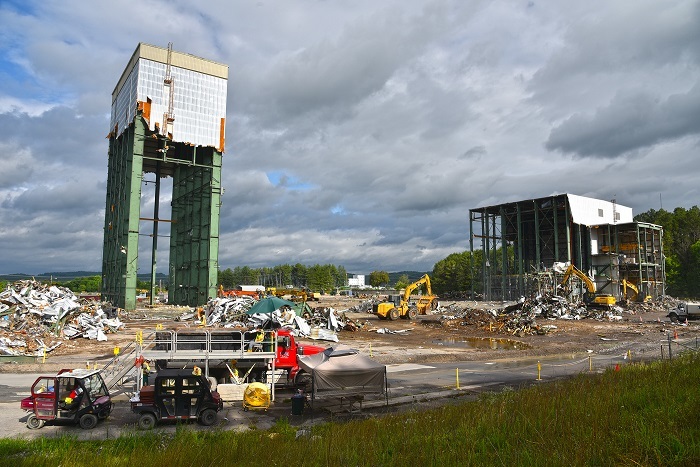 Oak Ridge crews took down numerous facilities to complete the historic first-ever removal of a uranium enrichment complex this year. Pictured is the Centrifuge Complex, which towered 180 feet tall in some sections.
WASHINGTON, D.C. – DOE’s Oak Ridge Office of Environmental Management (OREM) and its environmental cleanup contractor UCOR were honored Nov. 12 with the Government Team Project of the Year Award.
The recognition was part of the national 2020 Washington Exec Pinnacle Awards, which go to top businesses and organizations that are saving money and fostering innovation.
Oak Ridge received the award for the significant effort involved in completing major cleanup earlier this year at the East Tennessee Technology Park (ETTP), a former uranium enrichment complex. This accomplishment, two decades in the making, removed more than 500 dilapidated and contaminated structures and opened land for economic development for the community.
The award highlighted the effectiveness and efficiency of the work by OREM and UCOR. They ultimately finished the project $80 million under budget and four years ahead of schedule, avoiding $500 million in costs to taxpayers.
“I’m very proud to be part of this federal team and to be partnered with an outstanding contractor like UCOR,” OREM Manager Jay Mullis said. “Together, we’ve completed DOE’s largest cleanup project to date and established a well-deserved reputation of conducting our work safely, on time, and cost effectively.”
 A view of the East Tennessee Technology Park after cleanup was completed at the former uranium enrichment complex this year. The work was completed four years ahead of schedule, saving taxpayers $500 million.
The award cited numerous innovative approaches taken to achieve the accomplishment that resulted in a historic first-ever removal of a uranium enrichment complex. Those innovations included reducing or eliminating the need for human entry into potentially hazardous environments, implementing a dispose-as-you-go waste approach, and creating a secure onsite disposal facility connected to ETTP by a private road exclusively used for waste shipments.
UCOR President and CEO Ken Rueter said that a strong partnership with the client and a workforce dedicated to safety were key to success.
“Our shared governance approach brought all of the players to the table and everyone had a voice — our client, our workforce, labor, regulators, and various stakeholders within the community,” Rueter said. “This strong collaborative approach enabled this very successful outcome.”
-Contributor: Susanne Dupes
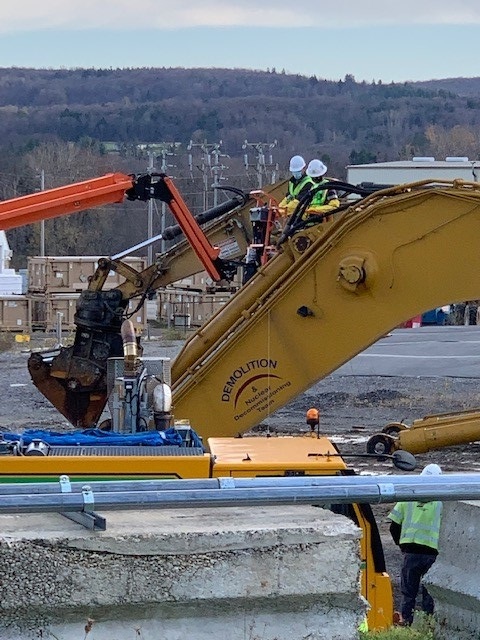
WEST VALLEY, N.Y. – Crews prepared a large demolition excavator for the installation of a long-reach arm as they readied for the future teardown of the last remaining major facility at the West Valley Demonstration Project, an EM 2020 priority. Built in the 1960s, the Main Plant Process Building was used as a commercial reprocessing facility to recover reusable plutonium and uranium from spent nuclear reactor fuel. The five-story facility operated from 1966 to 1972, processing about 640 metric tons of irradiated nuclear fuel. EM and cleanup contractor CH2M HILL BWXT West Valley also recently began grouting a large underground cell at the site to provide structural stability for when heavy demolition equipment operates aboveground to tear down the Main Plant Process Building. The cell, which is nearly 30 feet below ground, will remain in place until the underground portion of the Main Plant Process Building is removed in the future.
-Contributor: Joseph Pillittere
|
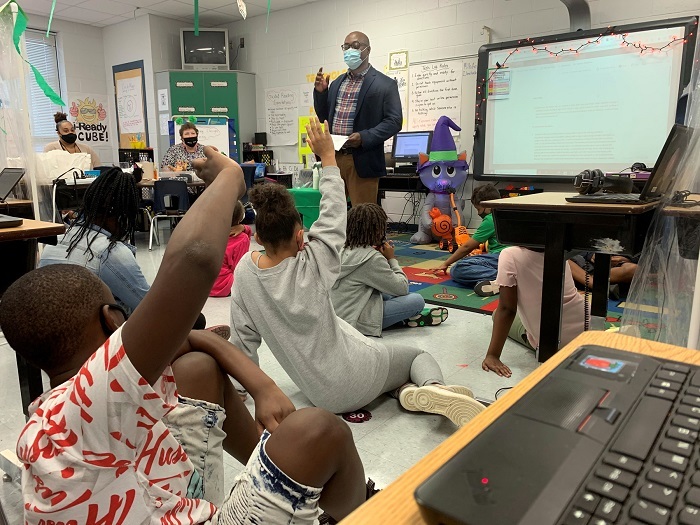 Savannah River Operations Office Engineer Joel Maul talks with students at Diamond Lakes Elementary School in Hephzibah, Georgia during a visit after several weeks of correspondence with the students.
AIKEN, S.C. – Students are becoming pen pals with Savannah River Site (SRS) employees whose degrees and careers involve science, technology, engineering, and math (STEM) in a new program called “STEMulating Conversations with SRS Experts.”
To date, 74 teachers and academic officials from local schools have enrolled in the pilot program in which K-12 grade students send letters via email to the SRS experts to learn about a range of STEM careers.
Managed by EM contractor Savannah River Nuclear Solutions (SRNS), STEMulating Conversations offers students the opportunity to develop career aspirations and interests in STEM by communicating with scientists, engineers, IT, and other STEM professionals from SRS. Through this program, they can ask SRS experts questions about STEM and their careers.
Students in the STEM Lab at Diamond Lakes Elementary in Hephzibah, Georgia have been exchanging information with chemical engineer Joel Maul and electrical engineer Pamela Finklin at SRS. Their different engineering focuses give students a variety of perspectives on careers.
“There’s little doubt that the ongoing correspondence is already creating a mentoring relationship between the students at Diamond Lakes and our SRS engineers,” said STEMulating Conversations Program Coordinator Taylor Rice, who works with the SRNS education outreach division. “It’s been exciting for me to read the letters as well and see the enthusiasm they are generating. Each message from Pamela and Joel benefits 160 students from Diamond Lakes and exposes them to two different engineering fields.”
Diamond Lakes Principal Lashantel Pinckney expressed her appreciation for the partnership between SRS engineers and the Richmond County School System.
“Our district is truly appreciative of the efforts made by SRNS Education Outreach to think outside the box during the pandemic and to remain engaged in the business of educating and preparing students for their future,” Pinckney said.
Rice uses a database of more than 90 SRS volunteers to determine the best match for questions that come in from students.
“This program is already proving to be a great way for students to begin thinking about what engineers, scientists, or other STEM professionals do within their chosen profession,” Rice said. “One of our beliefs is that you can’t wait until college to reach students with this type of information. You have to reach them early, at the elementary grade level and then continue the dialogue as they advance into middle and high school.”
STEMulating Conversations with SRS Experts will soon move from a pilot program to an annual one offered by SRNS.
“Students need this kind of connection and the acknowledgement that people care about them and their career goals,” Rice said. “We have so much talent and knowledge in different areas to share throughout the Savannah River Site.”
-Contributor: DT Townsend
|